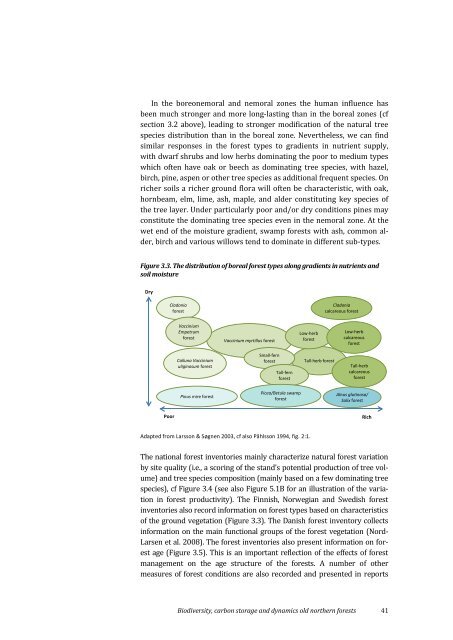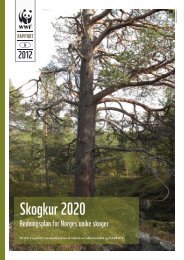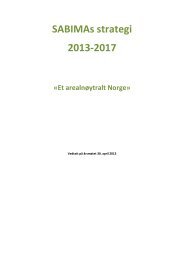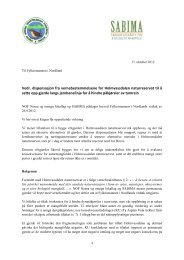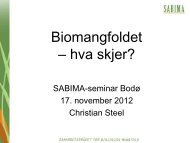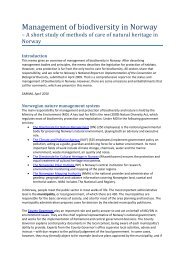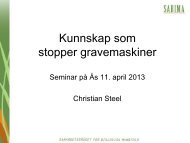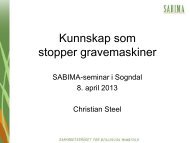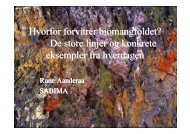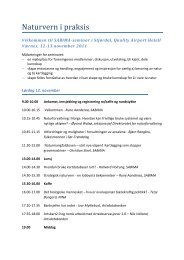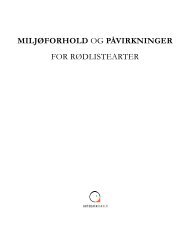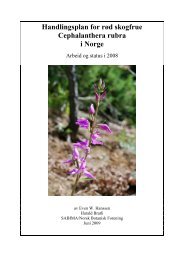Biodiversity, carbon storage and dynamics of old northern ... - BPAN.fi
Biodiversity, carbon storage and dynamics of old northern ... - BPAN.fi
Biodiversity, carbon storage and dynamics of old northern ... - BPAN.fi
Create successful ePaper yourself
Turn your PDF publications into a flip-book with our unique Google optimized e-Paper software.
In the boreonemoral <strong>and</strong> nemoral zones the human influence has<br />
been much stronger <strong>and</strong> more long-lasting than in the boreal zones (cf<br />
section 3.2 above), leading to stronger modi<strong>fi</strong>cation <strong>of</strong> the natural tree<br />
species distribution than in the boreal zone. Nevertheless, we can <strong>fi</strong>nd<br />
similar responses in the forest types to gradients in nutrient supply,<br />
with dwarf shrubs <strong>and</strong> low herbs dominating the poor to medium types<br />
which <strong>of</strong>ten have oak or beech as dominating tree species, with hazel,<br />
birch, pine, aspen or other tree species as additional frequent species. On<br />
richer soils a richer ground flora will <strong>of</strong>ten be characteristic, with oak,<br />
hornbeam, elm, lime, ash, maple, <strong>and</strong> alder constituting key species <strong>of</strong><br />
the tree layer. Under particularly poor <strong>and</strong>/or dry conditions pines may<br />
constitute the dominating tree species even in the nemoral zone. At the<br />
wet end <strong>of</strong> the moisture gradient, swamp forests with ash, common alder,<br />
birch <strong>and</strong> various willows tend to dominate in different sub-types.<br />
Figure 3.3. The distribution <strong>of</strong> boreal forest types along gradients in nutrients <strong>and</strong><br />
soil moisture<br />
Dry<br />
Cladonia<br />
forest<br />
Cladonia<br />
calcareous forest<br />
Vaccinium<br />
Empetrum<br />
forest<br />
Vaccinium myrtillus forest<br />
Low-herb<br />
forest<br />
Low-herb<br />
calcareous<br />
forest<br />
Calluna Vaccinium<br />
uliginosum forest<br />
Small-fern<br />
forest<br />
Tall-fern<br />
forest<br />
Tall-herb forest<br />
Tall-herb<br />
calcareous<br />
forest<br />
Pinus mire forest<br />
Picea/Betula swamp<br />
forest<br />
Alnus glutinosa/<br />
Salix forest<br />
Poor<br />
Rich<br />
Adapted from Larsson & Søgnen 2003, cf also Påhlsson 1994, <strong>fi</strong>g. 2:1.<br />
The national forest inventories mainly characterize natural forest variation<br />
by site quality (i.e., a scoring <strong>of</strong> the st<strong>and</strong>’s potential production <strong>of</strong> tree volume)<br />
<strong>and</strong> tree species composition (mainly based on a few dominating tree<br />
species), cf Figure 3.4 (see also Figure 5.1B for an illustration <strong>of</strong> the variation<br />
in forest productivity). The Finnish, Norwegian <strong>and</strong> Swedish forest<br />
inventories also record information on forest types based on characteristics<br />
<strong>of</strong> the ground vegetation (Figure 3.3). The Danish forest inventory collects<br />
information on the main functional groups <strong>of</strong> the forest vegetation (Nord-<br />
Larsen et al. 2008). The forest inventories also present information on forest<br />
age (Figure 3.5). This is an important reflection <strong>of</strong> the effects <strong>of</strong> forest<br />
management on the age structure <strong>of</strong> the forests. A number <strong>of</strong> other<br />
measures <strong>of</strong> forest conditions are also recorded <strong>and</strong> presented in reports<br />
<strong>Biodiversity</strong>, <strong>carbon</strong> <strong>storage</strong> <strong>and</strong> <strong>dynamics</strong> <strong>old</strong> <strong>northern</strong> forests 41


